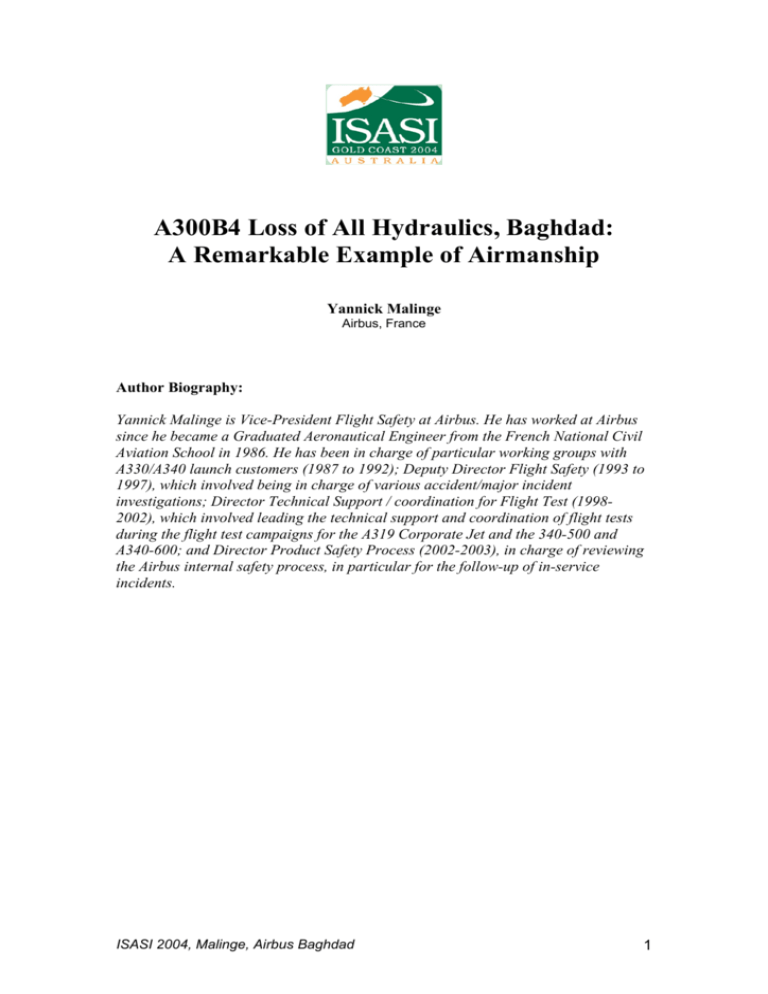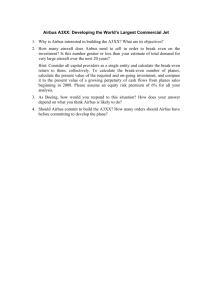A Remarkable Example of Airmanship
advertisement

A300B4 Loss of All Hydraulics, Baghdad: A Remarkable Example of Airmanship Yannick Malinge Airbus, France Author Biography: Yannick Malinge is Vice-President Flight Safety at Airbus. He has worked at Airbus since he became a Graduated Aeronautical Engineer from the French National Civil Aviation School in 1986. He has been in charge of particular working groups with A330/A340 launch customers (1987 to 1992); Deputy Director Flight Safety (1993 to 1997), which involved being in charge of various accident/major incident investigations; Director Technical Support / coordination for Flight Test (19982002), which involved leading the technical support and coordination of flight tests during the flight test campaigns for the A319 Corporate Jet and the 340-500 and A340-600; and Director Product Safety Process (2002-2003), in charge of reviewing the Airbus internal safety process, in particular for the follow-up of in-service incidents. ISASI 2004, Malinge, Airbus Baghdad 1 A300B4 Loss of All Hydraulics, Baghdad: A remarkable example of airmanship Presented by: Yannick Malinge, Vice-President Flight Safety - Airbus Introduction: On November 22, 2003 an all-cargo A300, operated by DHL, registered OO-DLL, took off from Baghdad, bound for Bahrain. It was the A300B4, serial n° 94, manufactured in March 3, 1980. On board, the crew: Eric the pilot-in-command also Pilot Flying, Steve the First Officer also Pilot Non Flying, and Mario the Flight Engineer. At the time of the event, the Captain had accumulated a total of 3300 flight hours, including 1786 on type. The First Officer had accumulated a total of 1275 flight hours, including 199 on type and the Flight Engineer had accumulated a total of 13423 flight hours, including 1709 on type. They were prepared for a routine mission, transporting essentially mail to their intended destination from Baghdad to Bahrain. At about 8000 ft, a missile hit the left wing of the aircraft leading to the loss of all hydraulics systems. With a remarkable airmanship and CRM, the crew managed to safely land the aircraft using only the engine thrust which was the only remaining means to control the aircraft. Three crew members, in a seemingly impossible situation, succeeded in recovering a measure of control and thus saving themselves and their aircraft. This extraordinary feat was achieved in spite of the extreme stress of the situation; they analysed the problems and worked as a crew to manage the priorities. 1/ EVENT DESCRIPTION The Take-Off The weather is clear, it is a short leg with a light load, the Take-Off weight being only 100 tons, well below the MTOW of 165.9 tons . Aligned on runway 15 Left, the brakes are released and the thrust applied. The lightly loaded aircraft, in “slats only” configuration, is quickly airborne and slats retracted at low altitude, and climb established at 215 Kts for maximum gradient. The missile impact At about 8000 ft. an explosion rocks the aircraft, followed in a few seconds by a succession of aural warnings. The Flight Engineer announces that the green and yellow hydraulic systems are lost, and 20 seconds later the blue system is also losing pressure. ISASI 2004, Malinge, Airbus Baghdad 2 The aircraft is now without conventional pilot input. Stick and rudder ineffective. The flight control surfaces deprived of their hydraulic power, are aligned with the airflow (zero hinge moment). The configuration is frozen: − − − Slats and flaps cannot be extended, Spoilers are no longer controlled, The position of the horizontal stabilizer cannot be adjusted. It is and will remain at the trim position for 215 Kts with climb thrust. Flying the aircraft without hydraulic power. Total loss of hydraulics is quickly identified. A state of emergency is declared by the PNF to ATC. The crew is advised that the left wing is on fire. The aircraft continues to climb and stabilizes with moderate left bank. A learning period begins during which the crew discovers how to control pitch by modulating thrust. Initially the thrust lever movements are large and essentially symmetrical, and the turn to the left thus continues, the aircraft performing a wide unsteady 360° turn. The crew finds that they can effectively stop the climb by reducing thrust, but that this also causes the airspeed to increase. They must cope with this apparent paradox, due to the change in pitching moment that cannot be corrected by the jammed horizontal stabilizer. The PF orders extension of the landing gear by the emergency gravity extension procedure, even though the speed already slightly exceeds 270 knots, the maximum allowed for landing gear extension. The gear comes down providing additional drag. This is the only means to bring the speed back towards 210 knots. Now that the aircraft is controllable in pitch around level flight and at a speed compatible with landing, The PF learns to control the direction of flight. The explosion of the missile has torn away a significant part of the left wing, between the trailing edge and the web of the rear-spar, which is also the aft wall of the outboard fuel tank. 3500 kg of fuel pour out, and ignite rapidly. There is a worsening dual asymmetry, of shape and of weight, between the left and the right wings, which is causing a continuous left turn. This must be corrected to enable a return to the airfield. Asymmetric handling of the throttles can control bank. When the left engine alone is accelerated, the wings return to the horizontal, as when the right engine only is retarded. But it’s not easy: − − The response to thrust change appears fast in pitch, but roll response is delayed, since the roll results from the sideslip induced by the asymmetric thrust, and there is a lag before this takes effect. Since the left wing is damaged, the degree of asymmetric thrust must be found which is sufficient to compensate for the asymmetry of lift, and it must be maintained while the thrust is adjusted to control the slope. Easier to say than to do ! ISASI 2004, Malinge, Airbus Baghdad 3 Approach Finally, the PF learns this particular trick of performing such throttle gymnastics fairly quickly, and after several roll excursions slightly beyond 30°, confidence was gained. Now he can consider navigating back to the field which he has lost sight of during these “training maneuvers”. The PNF takes on the navigation. A long final is needed, at least 20 nautical miles. After a second 360° turn to the left, followed by a straight outbound leg, the PF starts a right turn to come back towards runway 33 R, the longer of the two runways at Baghdad. The descent flight path must now be established. That is not simple either: the descent angle selected by the average value of thrust is not easy to assess, since the whole process is subject to the phugoid oscillation. It is thus an average descent angle that must be judged, all the while maintaining the heading by asymmetric adjustment of the engines. This is not instinctive when the pitch is varying between 0° and 5° with a period of about one minute! To complicate matters further, the turbulence associated with a wind of 20 knots from 290° (left crosswind component) tends to excite natural oscillations, and in addition GPWS warnings associated with the abnormal landing configuration sound repeatedly on short final. The alignment is difficult: The PF adapts his objectives to the limited means of control available: − − Runway 33 L seems closer to the actual track, let’s go for the left runway. Speed is high, OK to touch down at 220 knots considering the overall situation, in particular since it is determined by the crew that at such speed, they can control the a/c. The PF concentrates on the essential, keep the aircraft under control and reach the airfield where there are firemen services to fight the fire on the left wing. The PNF assists with efficient and timely call-outs, announces distances and altitudes. He recalls that the power must not be completely reduced; otherwise the symmetrical thrust would induce a turn to the left, particularly undesirable before ground contact. The Flight Engineer monitors the fuel remaining in the damaged left wing. It is vital that both engines continue to run. He stays therefore prepared to open the cross feed in case the left main (n°1) tank empties, but not to soon because the fuel in the right wing would then be lost through the leak on the left side! At 250 feet, the pitch attitude, still slowly oscillating, drops towards a negative value, which is most alarming so close to the ground. It is restored nose-up by a large increase in thrust on both engines. Towards 100 ft., the aircraft is tracking to the runway threshold, but with a heading 10° less than the orientation of the runway. The PF makes his final lateral control correction, reducing the right engine only. The aircrafts banks to the right and the angle of convergence begins to diminish, but thanks to the high thrust maintained on the left engine, the aircraft does not dive towards the ground in the last few feet. ISASI 2004, Malinge, Airbus Baghdad 4 Landing Twenty-five long minutes after impact of the missile, the A300 lands on runway 33 L, without further damage: − − − At a positive pitch attitude (slightly above 2°), With a moderate sink rate (in any case less than the 10 ft./sec. for which the landing gear is designed), And a bank angle of 10° to the right, and heading diverging about 8° to the left of the runway axis. Still without any direct means of directional control, the aircraft rapidly goes off the side of the runway. The throttles are now retarded and selected to full reverse. The sandy ground provides a significant extra braking force. Overall the braking is very effective (approximately 0.5 g deceleration) and the aircraft, in spite of the high speed at touchdown, stops after a landing run of the order of one kilometre. The aircraft is finally stopped with the nose within the airport enclosure. It only remains to evacuate by the right escape-slide… ISASI 2004, Malinge, Airbus Baghdad 5 2/ CONCLUSION This flight, which was concluded so fortunately, should be brought to the attention of the world community of pilots, just as was the flight of the DC-10 at Sioux City. It is a good lesson in Flight Safety which must not be forgotten. Lessons in terms of Crew Resource Management The crew, in a seemingly impossible situation, succeeded in recovering a measure of control and thus saving themselves and their aircraft. This extraordinary feat was achieved in spite of the extreme stress of the situation; they analysed the problems and worked as a crew to manage the priorities. Lessons in terms of Training Following the event, discussions and questions were raised regarding the need or not to train pilots to face similar situation. Airbus came to the following conclusions: Each such situation is unique and cannot be trained for in advance. Therefore training is not appropriate, however pilot community should know the basic principles. - Crew will have to adapt himself, applying the following basic principles - Pitch is controlled by thrust - Speed must be accepted (provided vertical speed is controlled) - Roll is controlled by differential thrust with considerable time response - DO NOT RETARD thrust at flare ISASI 2004, Malinge, Airbus Baghdad 6 3/ CONGRATULATIONS At a time when the finger is so often pointed at pilots, let us congratulate them for the extraordinary demonstration of the adaptability of humans to master such an improbable situation. WELL DONE Eric, Steve, Mario ISASI 2004, Malinge, Airbus Baghdad 7






